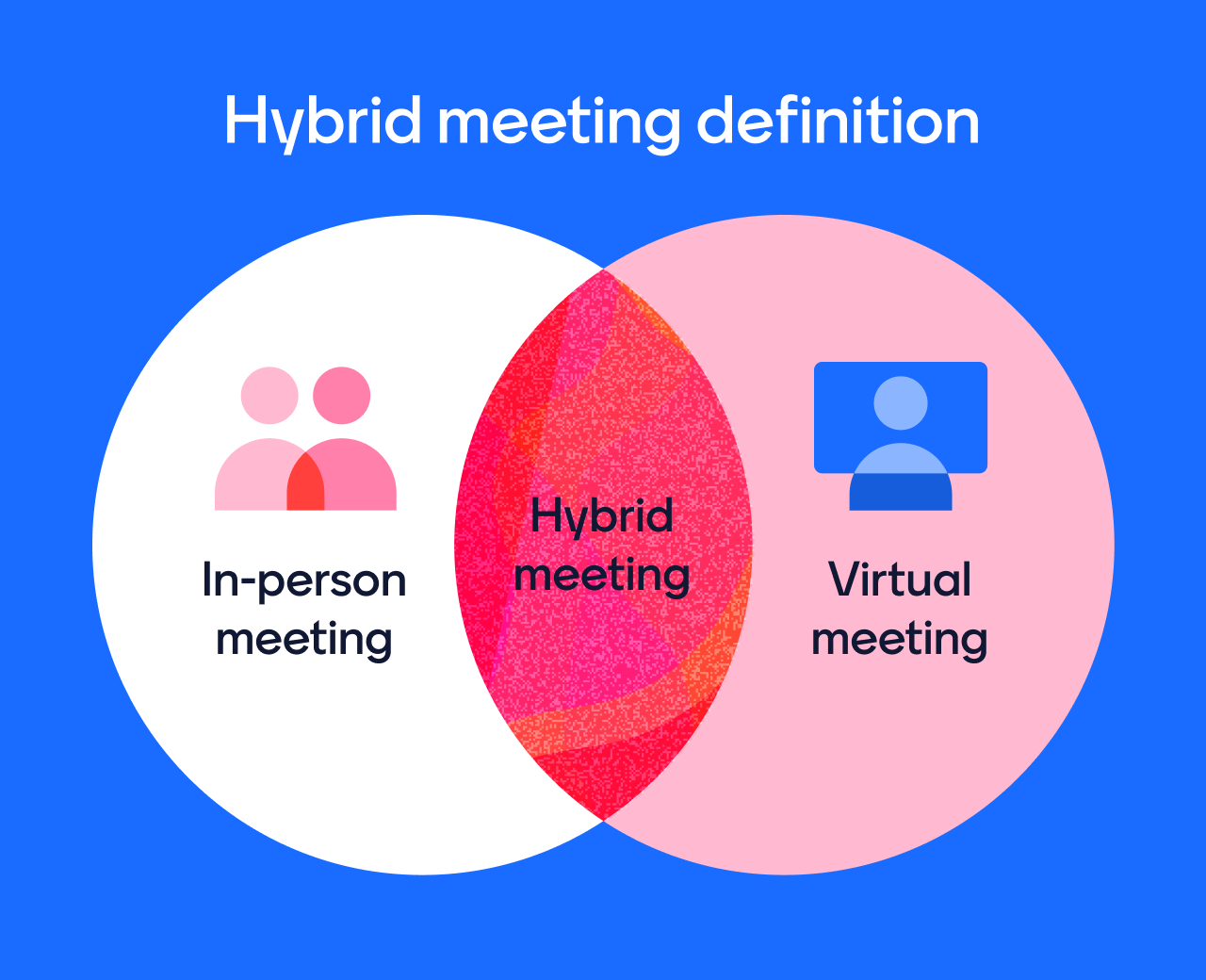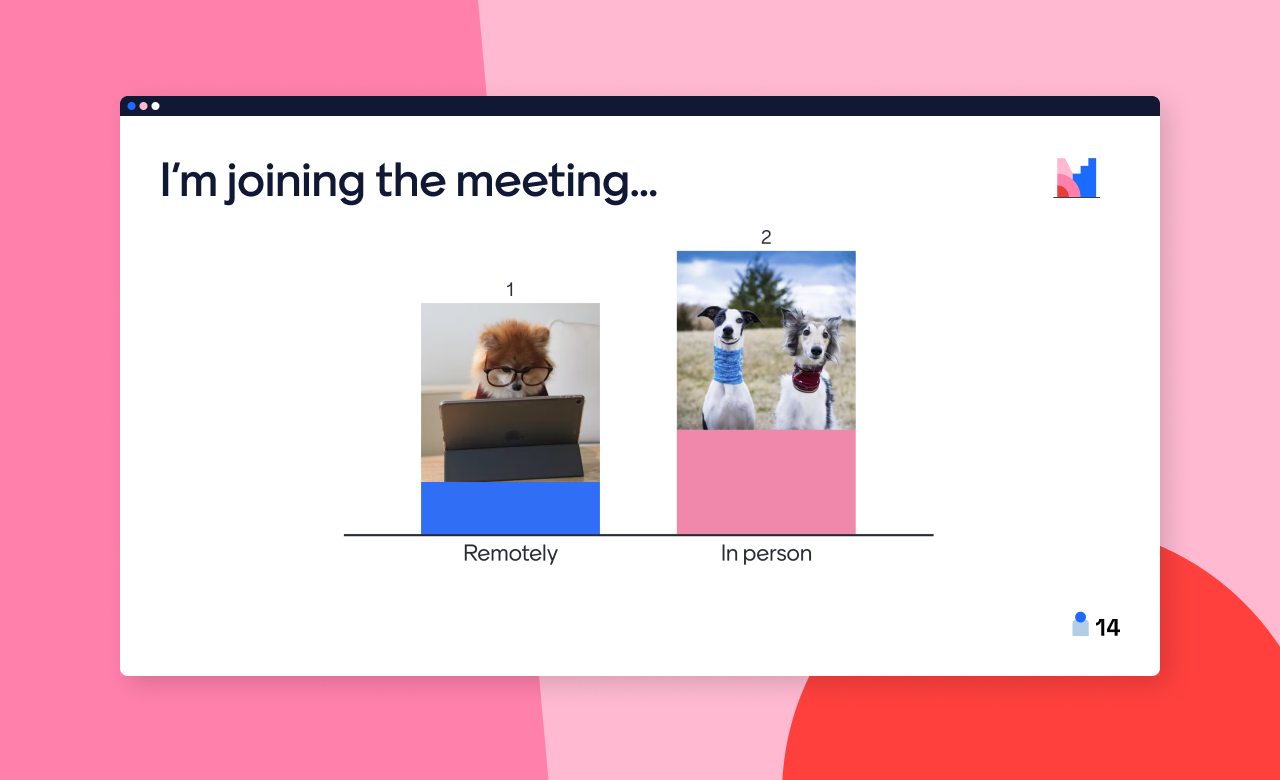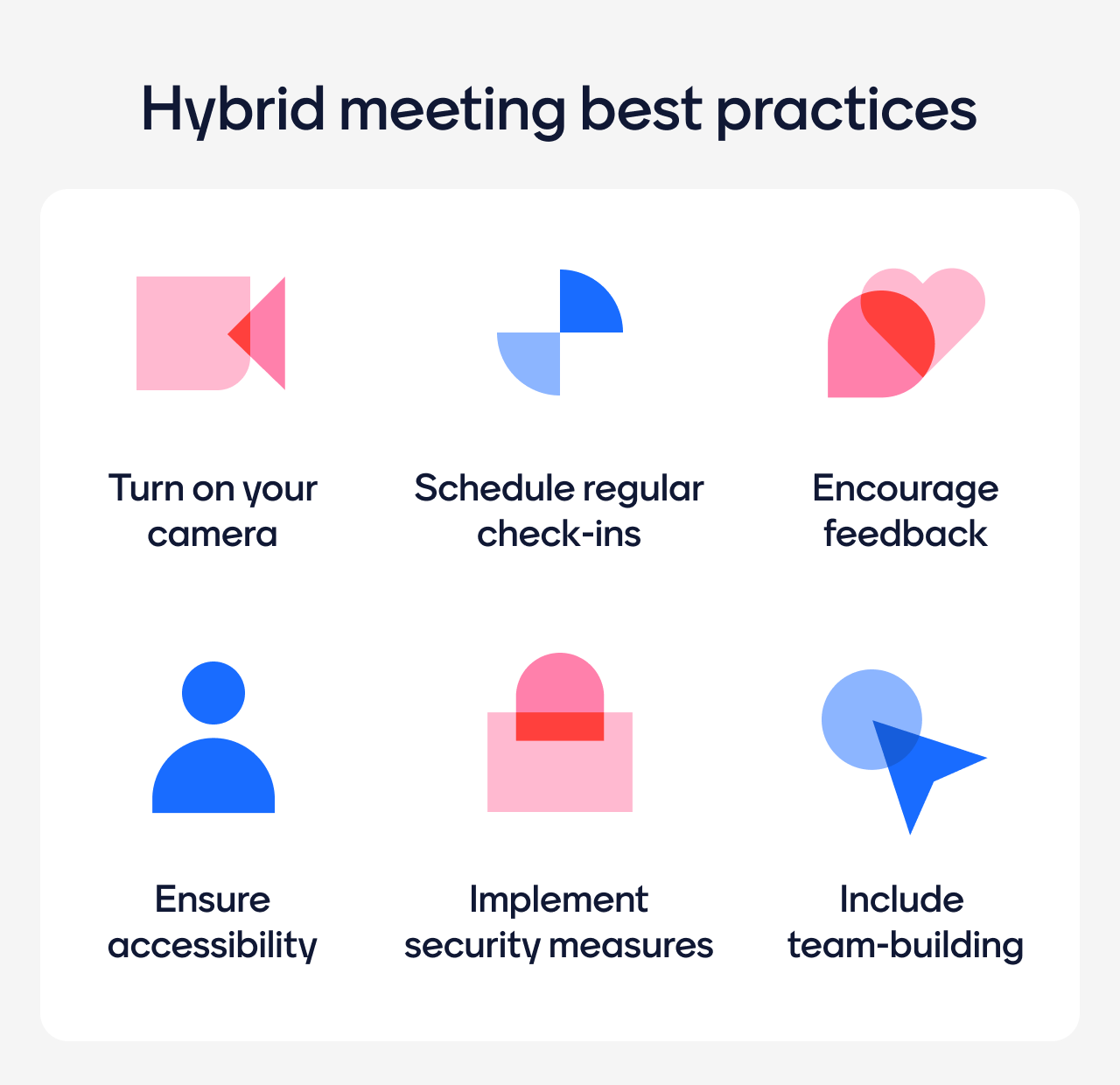Hybrid meetings allow both in-person and remote participants to engage and contribute to discussions seamlessly, regardless of physical location. With today’s diverse work styles, it’s essential to know how to run one without sacrificing engagement.
Since 2022, nearly half of us have worked in a hybrid setting — and 1 in 5 has gone completely remote.
With great flexibility comes great responsibility, yet maintaining employee engagement is still one of the biggest challenges workplaces face since the shift to hybrid work.
Why? The problem lies in strategy. You can’t just copy-paste in-office rules of engagement and expect the same results in a hybrid setting.
From dealing with distractions to navigating tech hiccups, holding successful hybrid meetings calls for a new approach. In this article, we’ll cover essential steps to running hybrid meetings as well as tips and best practices for better collaboration.
What is a hybrid meeting?

Hybrid meetings are a fusion of in-person and virtual attendance that became more common during the COVID-19 pandemic. With the rise of remote work and the need for flexible schedules, hybrid meetings were designed to accommodate diverse work styles and locations.
But hybrid meetings didn’t just stay in the pandemic — today, they’re used to break down the walls of traditional meeting spaces, allowing for a more inclusive and adaptive approach to collaboration.
Benefits and drawbacks of hybrid meetings
Hybrid meetings are a game-changing solution that blends in-office participation with the flexibility of virtual attendance. But, like any new concept, the shift to hybrid brings its own set of challenges.

While hybrid work offers many benefits, like better flexibility and a worldwide talent pool, organizations may struggle with technical and cultural adaptations. Here are a few benefits and drawbacks to consider when adopting hybrid meetings:
Benefits of hybrid meetings
- Flexibility and inclusivity: Hybrid meetings break down geographical barriers, letting team members participate from anywhere.
- Cost savings and efficiency: Hybrid meetings can save money by cutting the need for extensive travel. This helps make operations more efficient.
- Better work-life balance: The option for remote participation in hybrid meetings lets employees balance professional commitments with their personal lives.
- Wider talent pool: Hybrid meetings open the door to a broader talent pool, allowing organizations to hire skilled individuals no matter where they are. This helps enrich diversity and expertise within the team.
- Reduced environmental impact: By limiting the time and travel required for in-office meetings, hybrid models can help shrink your environmental footprint.
Drawbacks of hybrid meetings
- Technical challenges: We’ve all been there. The tech aspect of hybrid meetings also means there’s more that can go wrong! Technical glitches, such as connectivity issues or hardware malfunctions, can disrupt the flow of the meeting. (Karen, you’re still on mute…)
- Communication gaps: Balancing communication between in-person and remote participants can be difficult, leading to potential misunderstandings, overlooked contributions, and even a sense of disconnection among team members.
- Engagement issues: Maintaining equal engagement levels for both in-person and remote attendees requires effort, as virtual participants may struggle to feel connected to the discussions.
- Logistical complexities: Coordinating hybrid meetings demands careful planning, from scheduling considerations to making sure everyone has access to the necessary tech.
- Cultural shift considerations: Switching to a hybrid model likely means a cultural shift within the organization. Teams may need to tweak leadership approaches, team dynamics, and expectations, which takes time.
How to run a hybrid meeting
When it comes to holding hybrid meetings, careful planning is key. From time zone differences to tech checks, we broke down the most important steps on how to run a successful hybrid meeting.
1. Create a hybrid meeting agenda
A hybrid team meeting agenda serves as the north star for both in-office and remote team members. No matter the location, a clear agenda gives a short and sweet overview of what to expect during the meeting, allowing everyone to prepare helpful materials and insights beforehand.
A well-rounded hybrid meeting agenda typically includes key components like:
- The purpose of the meeting: The purpose sets the stage for the meeting and lets your team know why it’s being held in the first place.
- Specific goals or decisions to be addressed: Clear goals and decisions provide a roadmap for what needs to be accomplished during the meeting.
- Relevant context for each agenda item: Providing some background for each agenda item helps everyone understand how it relates to the overall meeting objective (and how their role plays a part).
Make sure to send your agenda to all participants well in advance so they have plenty of time to prepare their feedback and thoughts.

2. Build an inclusive communication plan
Clear communication channels level the playing field for both in-office and at-home participants, making sure everyone has the info they need to jump into the conversation.
When your team communicates well, you can dodge those pesky miscommunications that pop up when you’re not all in the same room. That’s why communication is so important for creating a meeting space where everyone feels seen and heard.
To encourage inclusive communication:
- Set clear expectations and best communication practices for all participants.
- Encourage active participation from both in-office and remote team members, making time for feedback during discussions and decision-making processes.
- Use hybrid meeting tools that allow real-time interaction so virtual participants can easily share their thoughts.
- Encourage remote users to turn on their cameras during meetings. Face-to-face interactions have been proven to boost engagement and connection. (Plus, it’s a bit harder to doze off on camera!)
Providing guidelines for effective communication and using innovative tech helps create a more cohesive and collaborative hybrid meeting experience.
3. Check your tech
Blackouts, dead mics, and connection issues, oh my! Tech issues are inevitable, but a quick pre-meeting tech check can help you avoid most of these problems. Try:
- Checking audiovisual equipment in the physical meeting space
- Confirming the reliability of virtual collaboration tools
- Completing all necessary software updates
These preparations can prevent potential disruptions during the meeting, so everyone can say their piece without having to pause to fidget with their headset.
4. Designate a facilitator
Every good meeting needs a captain — someone who can steer the ship and encourage communication between participants.
Choose a top-tier facilitator who can help navigate tech challenges, quickly address issues, and actively involve all participants in the conversation while keeping the meeting on track.
5. Take notes
How often have you walked out of a meeting and immediately forgot what was said? Meticulous meeting minutes capture valuable information, decisions, and action items for future reference.
Assign a notetaker before your hybrid meeting, or use collaborative tools that allow real-time documentation, like Google Docs. New technology like shared virtual whiteboards and AI assistants can also help streamline the note-taking process.
6. Use digital collaboration tools
One of the biggest pain points when running hybrid meetings is making sure all participants are actively engaged. That’s why digital collaboration tools like Mentimeter are a game-changer for better engagement and collaboration between in-person and remote participants.
Activities like polls, surveys, word clouds, and Q&A sessions let team members share thoughts, ideas, and feedback in real time — regardless of their physical location. By using these tools, hybrid meetings become more than just a discussion; they turn into collaborative sessions that make use of the entire team’s collective knowledge.
Other ideas for better hybrid collaboration include:
- Document sharing (Google Workspace, Dropbox)
- Centralized project management tools (Trello, Basecamp)
- Real-time messaging and communication (Slack, Microsoft Teams)
- Collaborative note-taking (Evernote, Notion)
- Screen sharing (TeamViewer, AnyDesk)
7. Keep time zones in mind
Navigating time zones is a bit like herding cats, especially if participants are working from different states or countries. Some participants may even have to sacrifice their mornings or evenings so they can attend the meeting.
When scheduling your meeting, keep fairness and flexibility top of mind. This might involve:
- Rotating meeting times to make sure that no one group is consistently burdened with early-morning or late-night sessions
- Using scheduling tools that display multiple time zones to help find a meeting time that aligns with everyone's work hours
Sometimes, finding a time that works for everyone just isn’t possible. In these cases, record the meeting for those who can't make it to make sure they’re up-to-date on key decisions and action items discussed.
Tips and best practices for hybrid meetings

Hybrid meetings should not only be productive but also build a sense of connection and engagement among participants — in-office or not. Here are a few of our best tips for making the most of your meeting:
- Turn on your camera: Ask participants — especially those attending remotely — to turn on their cameras during hybrid meetings. Yeah, we all have those messy-hair days, but studies show that keeping your camera on can improve accountability and focus. So it’s worth it!
- Encourage feedback: Let’s be real — perfection takes practice. Running great hybrid meetings is a learned skill, and asking for feedback during and after the meeting can help make you better the next time around.
- Ensure accessibility: Prioritize accessibility by making sure all participants can access meeting materials, presentations, and communication channels.
- Use security measures: We hate to admit it, but there’s always a possibility your Zoom meeting room gets hacked. Use security measures like passwords and encryption to protect any sensitive information discussed during your meeting.
- Include team-building activities: In-person water cooler chats are a thing of the past — it’s up to you to create bonding opportunities. Whether through virtual icebreakers, collaborative exercises, or informal discussions, team-building activities help contribute to a positive team culture.
Improve hybrid engagement with Mentimeter
Preparing engaging hybrid meetings is easier said than done, but with new innovative tools and techniques, they can be just as effective as traditional in-person presentations.
Whether you’re planning an important hybrid board meeting or holding a lecture for in-class and remote students, Mentimeter can help bridge the gap between in-person and virtual participants. With interactive features like live polls and anonymous Q&A sessions, Mentimeter makes it easy to ensure everyone feels seen and heard.



![10 interactive meeting tools for better collaboration [2024]](https://images.ctfassets.net/rvt0uslu5yqp/6h1BibM9TneeAnSwTwrAiB/2c5800b2f3455437af07bce0a76758e2/interactive-meeting-tools-hero.jpg?fm=webp&w=3840&q=75)